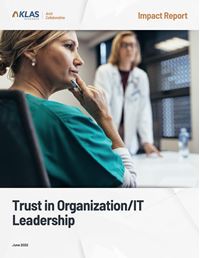Trust in Organization/IT Leadership 2022
Clinician perceptions of three key EHR stakeholders—their organization/IT leadership, their EHR vendor, and themselves as end users—impact their Net EHR Experience Score†. However, this impact is strongest with the first group—organization/IT leadership. A number of factors play into whether clinicians trust their organization/IT leadership, including EHR satisfaction, clinician burnout, EHR training, and support. This report aims to answer the question: How can organizations most effectively build trust with clinicians and ultimately improve their EHR experience?
Access the feedback of
500,000+ clinicians worldwide
Access the feedback of
500,000+ clinicians worldwide
Here is my information:
† Each individual clinician’s responses to the Arch Collaborative EHR Experience Survey regarding core factors such as the EHR’s efficiency, functionality, impact on care, and so on are aggregated into an overall Net EHR Experience Score (NEES), which represents a snapshot of the clinician’s overall satisfaction with the EHR environment at their organization. The NEES is calculated by subtracting the percent of negative user feedback from the percent of positive user feedback. An NEES can range from -100 (all negative feedback) to 100 (all positive feedback).
Trust in Organization/IT Leadership Has a Big Effect on Overall Experience
Since Arch Collaborative research began in 2017, participating organizations have seen improvements in some areas and declines in others. Despite an overall increase in the average NEES (by 16 points), clinician satisfaction with organizational EHR delivery has decreased by about 4 percentage points. The difference in clinicians’ NEES is dramatic depending on how they rate their organization/IT leadership. On average, there is a difference of 124.1 points in NEES between clinicians who strongly agree their organization/IT leaders deliver well and those who strongly disagree. (The same trend appeared in the Arch Collaborative’s last report on this topic.) This is especially important because clinician burnout is on the rise—fewer clinicians (by about 9 percentage points) report no burnout compared to four years ago. Organizations that have earned high trust from their clinicians are uniquely set up to address burnout.


Targeted Organizational Initiatives Drive Significant Satisfaction Improvement

In addition to seeing an increased NEES, repeat respondents for organizations that conduct pre/post surveys also report higher satisfaction with all three EHR stakeholders.

EHR Training, Efficiency, and Ease of Use Most Impact Trust in Organization/IT Leadership
A Boruta analysis (an algorithm used to determine what variables are most important to a particular metric) shows that the factors most important to clinicians’ perception of their organization/IT leadership are initial and ongoing EHR training, followed by agreement that the EHR enables efficiency, is easy to learn, and enables quality care. Organizations that focus on making strides in these areas will see higher satisfaction and trust from clinicians.

Utilizing Superusers Yields Higher Trust in Organization/IT Leadership
One common effort organizations make to improve satisfaction with ongoing training is using EHR superusers. Organizations that leverage superusers deeply embedded in their various departments also see higher ratings for trust in organization/IT leadership.

In Arch Collaborative case studies, organizations with standout EHR satisfaction share their keys to success, and there are currently 17 published case studies that relate to superusers. Below are some common recommendations (additional details are included in the Expanded Insights section of the report):
- Give every department/specialty a superuser
- Prior technical expertise isn’t necessarily needed
- Protected or paid time for superusers can be helpful
- Superusers are best deployed as a peer-to-peer aid resource to teach best practices, support adoption of personalization tools, and more
- Superusers are key to developing effective EHR education materials
- Superusers are extremely effective members of EHR governance boards
EHR Support of Patient-Centered Care Affects Organization Satisfaction
The EHR is supposed to be a tool that helps clinicians deliver high-quality care to patients. When clinicians feel the EHR doesn’t support high-quality, patient-centered care, they are much less likely to be satisfied with their EHR and their organization. A little over 44% of all Collaborative respondents disagree or are indifferent that their EHR enables patient-centered care. The Collaborative organizations that rate highest for agreement that the EHR enables patient-centered care also see much higher agreement (by 20 percentage points) that the organization and IT leadership deliver well, compared to organizations who score lower on this metric. For additional insights on how to make the EHR more patient-centric, see case studies from CentraCare Health, Royal Children’s Hospital Melbourne, and UVA Health.

What Is the KLAS Arch Collaborative?
The Arch Collaborative is a group of healthcare organizations committed to improving the EHR experience through standardized surveys and benchmarking. To date, over 250 healthcare organizations have surveyed their end users and over 240,000 clinicians have responded. Reports such as this one seek to synthesize the feedback from these clinicians into actionable insights that organizations can use to revolutionize patient care by unlocking the potential of the EHR. To participate in the Arch Collaborative, go to https://engage.klasresearch.com/klas-arch-collaborative/.
Report Non-Public HTML Body
Report Public HTML Body
Featured in Learning Track
Topics
Report Topics
Clinician Relationships & Communication, EHR GovernanceThis material is copyrighted. Any organization gaining unauthorized access to this report will be liable to compensate KLAS for the full retail price. Please see the KLAS DATA USE POLICY for information regarding use of this report. © 2019 KLAS Research, LLC. All Rights Reserved. NOTE: Performance scores may change significantly when including newly interviewed provider organizations, especially when added to a smaller sample size like in emerging markets with a small number of live clients. The findings presented are not meant to be conclusive data for an entire client base.



